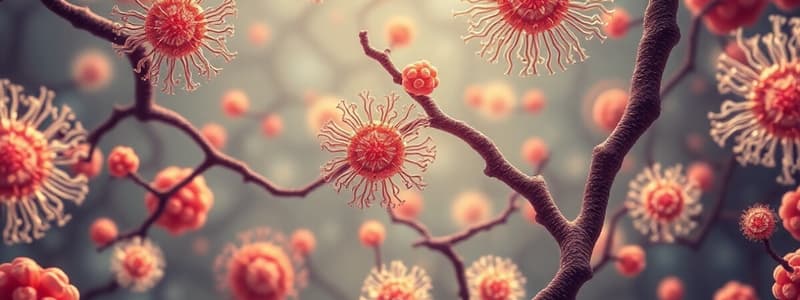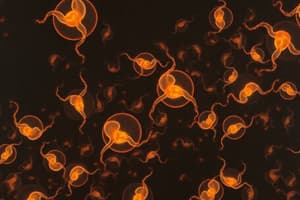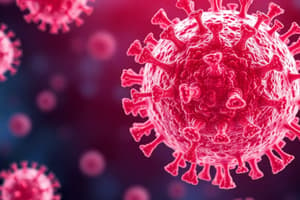Podcast
Questions and Answers
Adaptive immunity is characterized by its ability to recognize and defend against specific invaders. Which of the following attributes is essential to this form of immunity?
Adaptive immunity is characterized by its ability to recognize and defend against specific invaders. Which of the following attributes is essential to this form of immunity?
- Non-specific targeting of any foreign substance.
- Anatomical barriers preventing pathogen entry.
- Memory of past encounters with antigens. (correct)
- Rapid response time upon initial exposure.
While both B and T lymphocytes are key players in adaptive immunity, they differ in their primary mechanisms of action. What is the main function of B lymphocytes?
While both B and T lymphocytes are key players in adaptive immunity, they differ in their primary mechanisms of action. What is the main function of B lymphocytes?
- Suppressing the immune response to prevent autoimmunity
- Activating other immune cells through cytokine release
- Directly killing infected host cells
- Producing antibodies to target extracellular pathogens (correct)
Antigens are molecules recognized by the immune system. What characteristic makes a molecule likely to be identified as an antigen?
Antigens are molecules recognized by the immune system. What characteristic makes a molecule likely to be identified as an antigen?
- Its categorization as a carbohydrate rather than a protein.
- Its similarity to the body's own molecules.
- Its unique structure which the body recognizes as foreign. (correct)
- Its presence within the body since birth.
Exogenous antigens, endogenous antigens, and autoantigens each play a role in stimulating an immune response under different circumstances. Which of the following correctly describes an EXOGENOUS antigen?
Exogenous antigens, endogenous antigens, and autoantigens each play a role in stimulating an immune response under different circumstances. Which of the following correctly describes an EXOGENOUS antigen?
Epitopes are critical components in antigen recognition by the immune system. What is the primary role of an epitope?
Epitopes are critical components in antigen recognition by the immune system. What is the primary role of an epitope?
Major Histocompatibility Complexes (MHC) are essential for antigen presentation to lymphocytes. What is the primary function of MHC molecules?
Major Histocompatibility Complexes (MHC) are essential for antigen presentation to lymphocytes. What is the primary function of MHC molecules?
MHC I and MHC II proteins present antigens to T-cells. Which of the following best describes a key difference in their presentation?
MHC I and MHC II proteins present antigens to T-cells. Which of the following best describes a key difference in their presentation?
Antigen-presenting cells (APCs) play a crucial role in initiating adaptive immune responses. Which of the following cells is classified as an APC?
Antigen-presenting cells (APCs) play a crucial role in initiating adaptive immune responses. Which of the following cells is classified as an APC?
Which of the following statements accurately describes antigen processing and presentation?
Which of the following statements accurately describes antigen processing and presentation?
T cell receptors (TCRs) and B cell receptors (BCRs) are central to the adaptive immune response. What is the key difference in how these receptors recognize antigens?
T cell receptors (TCRs) and B cell receptors (BCRs) are central to the adaptive immune response. What is the key difference in how these receptors recognize antigens?
Costimulation is a critical step in the activation of T and B cells. What is the primary purpose of costimulation in the immune response?
Costimulation is a critical step in the activation of T and B cells. What is the primary purpose of costimulation in the immune response?
Cytokines, such as interleukins, play a key role in the immune system. How do interleukins primarily function?
Cytokines, such as interleukins, play a key role in the immune system. How do interleukins primarily function?
Following recognition and costimulation of T and B cells, what immunological event occurs?
Following recognition and costimulation of T and B cells, what immunological event occurs?
There are different types of T lymphocytes, each with a specialized function in the immune response. What is the primary role of cytotoxic T lymphocytes (Tc)?
There are different types of T lymphocytes, each with a specialized function in the immune response. What is the primary role of cytotoxic T lymphocytes (Tc)?
Helper T lymphocytes (Th) play a central role in coordinating the adaptive immune response. How do helper T cells primarily contribute to immunity?
Helper T lymphocytes (Th) play a central role in coordinating the adaptive immune response. How do helper T cells primarily contribute to immunity?
In cell-mediated immunity, infected cells displaying MHC I interact with which type of cell?
In cell-mediated immunity, infected cells displaying MHC I interact with which type of cell?
How does humoral immunity primarily function to combat pathogens?
How does humoral immunity primarily function to combat pathogens?
Plasma cells are a critical component of humoral immunity. What is their primary function?
Plasma cells are a critical component of humoral immunity. What is their primary function?
What part of the antibody structure leads to different types of antibodies?
What part of the antibody structure leads to different types of antibodies?
There are several classes of antibodies (IgM, IgG, IgA, IgE, IgD), each with a specific role in the immune response. Which antibody is the FIRST antibody produced during an acute infection?
There are several classes of antibodies (IgM, IgG, IgA, IgE, IgD), each with a specific role in the immune response. Which antibody is the FIRST antibody produced during an acute infection?
IgG, IgA and IgE antibodies each play a distinct role in humoral immunity. Which antibody is associated with body secretions such as mucous membranes?
IgG, IgA and IgE antibodies each play a distinct role in humoral immunity. Which antibody is associated with body secretions such as mucous membranes?
While antibodies are crucial for adaptive immunity, they don't directly kill microbes. Which of the following describes how antibodies assist in pathogen elimination?
While antibodies are crucial for adaptive immunity, they don't directly kill microbes. Which of the following describes how antibodies assist in pathogen elimination?
Adaptive immunity develops over time through exposure to antigens. Which of the following is a method for obtaining memory against a specific epitope?
Adaptive immunity develops over time through exposure to antigens. Which of the following is a method for obtaining memory against a specific epitope?
Interleukin 4 (IL-4) drives the adaptive immunity process. What is the effect of Interleukin 4 (IL-4)?
Interleukin 4 (IL-4) drives the adaptive immunity process. What is the effect of Interleukin 4 (IL-4)?
T cytotoxic (Tc) cells, in cell-mediated immunity, recognize infected cells through MHC I and endogenous antigens. What is the next step?
T cytotoxic (Tc) cells, in cell-mediated immunity, recognize infected cells through MHC I and endogenous antigens. What is the next step?
Flashcards
Adaptive Immunity
Adaptive Immunity
The body's ability to recognize and defend itself against specific invaders and their products.
Antigens
Antigens
Molecules, like surface proteins or lipids, that the body recognizes as foreign and worthy of attack.
Epitopes
Epitopes
Regions of the antigen, recognized by the immune system.
Exogenous Antigens
Exogenous Antigens
Signup and view all the flashcards
Endogenous Antigens
Endogenous Antigens
Signup and view all the flashcards
Autoantigens
Autoantigens
Signup and view all the flashcards
Major Histocompatibility Complexes (MHC)
Major Histocompatibility Complexes (MHC)
Signup and view all the flashcards
Antigen Presenting Cell (APC)
Antigen Presenting Cell (APC)
Signup and view all the flashcards
MHC I
MHC I
Signup and view all the flashcards
MHC II
MHC II
Signup and view all the flashcards
T Cell Receptor (TCR)
T Cell Receptor (TCR)
Signup and view all the flashcards
B Cell Receptor (BCR)
B Cell Receptor (BCR)
Signup and view all the flashcards
Costimulation
Costimulation
Signup and view all the flashcards
Cytokines
Cytokines
Signup and view all the flashcards
Interleukins (ILs)
Interleukins (ILs)
Signup and view all the flashcards
Cytotoxic T lymphocyte (Tc)
Cytotoxic T lymphocyte (Tc)
Signup and view all the flashcards
Helper T lymphocyte (Th)
Helper T lymphocyte (Th)
Signup and view all the flashcards
Memory T lymphocytes
Memory T lymphocytes
Signup and view all the flashcards
Regulatory T lymphocyte
Regulatory T lymphocyte
Signup and view all the flashcards
B Lymphocytes
B Lymphocytes
Signup and view all the flashcards
Antibody structure
Antibody structure
Signup and view all the flashcards
IgM
IgM
Signup and view all the flashcards
IgG
IgG
Signup and view all the flashcards
IgA
IgA
Signup and view all the flashcards
IgE
IgE
Signup and view all the flashcards
Study Notes
- Chapter 16 discusses adaptive immunity, which allows the body to recognize and defend against specific invaders and their products.
Attributes of Adaptive Immunity
- Specificity is due to the recognition of unique antigens
- Memory allows for recognition of the same antigens
- This immunity is not functional at birth
Lymphocytes
- Adaptive immunity depends on the activity of lymphocytes
- The two main types are B Lymphocytes (B cells) and T Lymphocytes (T cells)
B Lymphocytes (B cells)
- Involved in Humoral immunity, attacking invaders outside of cells in the blood
- Target extracellular pathogens and toxins
T lymphocytes (T cells)
- Involved in Cell mediated immunity, attacking infected cells
- Targets intracellular pathogens
Recognition of Antigens
- Both T and B cells need to recognize antigens
- Antigens are molecules like surface proteins, carbs, and lipids that the body identifies as foreign and worthy of attack
Types of Antigens
- Exogenous antigens are found outside a body's cells, including toxins and components of microbial cell walls, membranes, flagella, and pili
- Endogenous antigens are produced by microbes replicating inside a body's cells
- Autoantigens are self-made antigens
Epitopes
- Epitopes are three-dimensional regions of antigens recognized by the body
- Epitopes make each microbe unique
Major Histocompatibility Complexes (MHC)
- Epitopes are recognized by lymphocytes when displayed as Major Histocompatibility Complexes (MHC)
- MHC's are glycoproteins found in the membranes of most cells
- These hold and position epitopes for presentation to immune cells
- A cell that presents the antigen to the lymphocytes is called an Antigen Presenting Cell (APC)
MHC proteins
- There are two types of MHC proteins
- MHC I is present on all nucleated cells, except red blood cells
- MHC II is present on antigen-presenting cells (APCs)
- These include macrophages, dendritic cells, and B cells
Antigen Processing
- Autoantigens are displayed as self MHC's
- Endogenous and exogenous antigens are processed into MHC proteins to display the pathogen epitopes
- Depending on the cell this can be either MHC I if a nucleated cell or MHC I and MHC II if an antigen-presenting cell (APC)
T Cell Receptor (TCR) Protein
- T cells and B cells recognize pathogens displayed on MHC's
- T cells possess a T Cell Receptor (TCR) protein unique for each pathogen epitope
- There is a matching TCR for every possible epitope the person can contact
- B cells also possess B Cell Receptors (BCR) unique to pathogen epitopes
Recognition and Multiplication
- Recognition usually needs an Antigen Presenting Cell (APC)
- It can be a Macrophage, B cell, or Dendritic Cell
- Multiplication of T/B cells requires interaction between T/B and APC
- This interaction is called Costimulation
- Costimulation results in surface molecules interacting and the release of Cytokines
Immune Response Cytokines
- Interleukins (ILs) signal among leukocytes
Impact of Recognition and Costimulation
- Recognition and costimulation result in mass production of T/B cells to attack foreign epitopes
Cytotoxic T lymphocyte
- One of the T lymphocytes used, it does actual killing
- It directly kills other cells with perforins to punch holes in cells
Helper T lymphocyte
- A type of T lymphocytes which helps make the army
- It helps multiply B cells and cytotoxic T cells and includes type 1 (Th1) and type 2 (Th2)
Memory T Lymphocytes
- Remember the same epitope in the future
Regulatory T lymphocyte
- It is involved with autoimmune diseases and inhibits autoantigen attack
Additional important points for cells
- Infected cells display MHC I foreign epitopes
- APC displays both MHC I and MHC II
- Interleukin 12 produced by the APC causes Th to become Th1
- Interleukin 2 is produced by both Th1 and Tc
- Tc now attacks infected cells displaying MHC1 endogenous
B Cell Activation Characteristics
- Uses attacking in the blood before getting into cells, in the plasma
- It includes Humoral Immunity by production of ANTIBODIES to attack extracellular epitopes
Types of Lymphocytes in B Cell Activation
- B lymphocytes initially recognize foreign epitopes and act as APC to become plasma cells
- Plasma cells produce antibodies
- Helper T lymphocytes (T4, Th) help multiply B cells and cytotoxic T cells
- Memory B lymphocytes remember the same epitope in the future
B-cells Additional Important Points
- APC's (both dendritic and B) display MHC II
- Interleukin 4 causes Th to become Th2
- Interleukin 4 also causes B cell to become Plasma cells
- Antibodies from Plasma cells attack exogenous antigens
Antibody Structure
- Basic structure consists of 2 heavy chains, 2 light chains
- Each chain has a variable region creating an Antigen Binding Site
- The site is epitope specific
- The stem of the heavy chains leads to different types of antibodies
Stem Creates Different Antibodies
- Different Antibody types exist: IgM, IgG, IgA, IgE, and IgD
- IgM is the first antibody produced (acute)
- IgG is the most common and longest-lasting (chronic)
- IgA is associated with body secretions (mucous memb)
- IgE is involved in response to parasitic infections and allergies
- IgD exact function is not known
Effect
- Antibodies facilitate phagocytosis, lysis, agglutination/clumping, and neutralization
- Antibodies do not actively kill microbes
- Instead they assist in killing
Method of obtaining Memory
- One way of obtaining memory against a specific epitope is vaccination
Studying That Suits You
Use AI to generate personalized quizzes and flashcards to suit your learning preferences.




